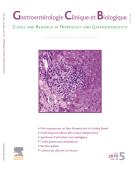Elytrocele with and without a history of hysterectomy (303 defecography studies) - 24/11/08
 , L. Henry b, F. Mion a, X. Barth c, E. Tissot c, G. Mellier d, H. Damon a
, L. Henry b, F. Mion a, X. Barth c, E. Tissot c, G. Mellier d, H. Damon aSummary |
Objective |
To search for clinical risk factors and symptoms of elytrocele in female patients without hysterectomy.
Patients and methods |
Of 1060 women who underwent defecography, radiographic evidence of elytrocele was observed in 303. History-taking was standardized, and included obstetric, surgical and medical history as well as clinical symptoms and their duration. Group A comprised 192 women with hysterectomy while group B included 111 women with no history of hysterectomy; these two groups were compared. Group B was also compared with patients who had neither elytrocele nor hysterectomy (group C; n=516).
Results |
Women in group B (no hysterectomy) were younger than those in group A (with hysterectomy) (57.9 years versus 62.8 years; p<0.05). Patients in group B had fewer obstetric (87.4% versus 97.9%; p=0.01) and abdominal (64.9 versus 82.3%; p=0.01) surgical events than those in group A, but more urinary tract surgery (18.9% versus 10.9%) and higher infant birth weights than patients in control group C. Six women (2%) had no surgical or obstetric history: mean age 42.7 years (20.6–74 years). Group B used protection against urinary soiling less often (17.3% versus 29.07%; p=0.017), but had more fecal soiling (23.4% versus 13.6%; p=0.033). Defecography showed that women in group B had more external rectal prolapse (17.7% versus 4.9%; p=0.003) and cystocele (48.6% versus 34.9%; p=0.019) than those in group A.
Conclusions |
This study was unable to identify risk factors of elytrocele in patients without hysterectomy except for a history of urinary tract surgery and higher infant birth weights. In some women, the elytrocele may be the result of significant rectal prolapse as part of a major pelvic floor disorder, predominantly in the posterior pelvis. Constitutional or congenital causes could also be involved as several young women free of any surgical or obstetric history nevertheless presented with an elytrocele.
Il testo completo di questo articolo è disponibile in PDF.Résumé |
Objectif |
Rechercher les facteurs de risque de l’élytrocèle chez les patientes non hystérectomisées et étudier la symptomatologie en rapport.
Patientes et méthodes |
Trois cent trois élytrocèles ont été identifiées parmi 1060 patientes ayant subi un viscérogramme pelvien. L’interrogatoire était standardisé et portait sur les antécédents obstétricaux, chirurgicaux et généraux, l’ancienneté des troubles et la symptomatologie. Une hystérectomie avait été réalisée dans 192 cas (groupe A) ; 111 patientes étaient non hystérectomisées (groupe B). Ces deux groupes ont été comparés. Les patientes non hystérectomisées avec élytrocèle (groupe B) ont également été comparées à un groupe contrôle de patientes non hystérectomisées sans élytrocèle (groupe C : n=516).
Résultats |
Les patientes du groupe B étaient plus jeune (57,9ans contre 62,8ans ; p<0,05) que les patientes du groupe A. Les patientes du groupe B présentaient moins d’antécédents obstétricaux (87,4 % versus 97,9 % ; p=0,01), moins d’antécédents de chirurgie abdominale (64,9 % versus 82,3 % ; p=0,01). Les antécédents de chirurgie urinaire étaient plus fréquents chez les patientes du groupe B, et le poids de naissance de leurs enfants plus important par rapport au groupe contrôle. Six patientes (2 %) ne présentaient aucun antécédent obstétrical ou chirurgical : leur âge moyen était de 42,7ans (20,6–74ans). Les patientes du groupe B utilisaient moins fréquemment des protections urinaires (17,3 % contre 29,7 % ; p=0,017), mais présentaient plus fréquemment des « soilings » (23,4 % contre 13,6 % ; p=0,033). Sur le plan radiologique, les patientes du groupe B présentaient plus souvent un prolapsus rectal extériorisé (17,7 % contre 4,9 % ; p=0,003) et une cystocèle (48,6 % contre 34,9 % ; p=0,019).
Conclusions |
Cette étude ne met pas en évidence de facteurs de risque d’élytrocèle spécifiques aux patientes non hystérectomisées hormis les antécédents de chirurgie urinaire et le poids de naissance. L’élytrocèle pourrait dans certains cas être la conséquence d’un prolapsus rectal important témoignant d’un trouble de la statique pelvienne prédominant au niveau postérieur. La survenue d’élytrocèle chez quelques patientes jeunes sans antécédent obstétrical ou chirurgical, confirme l’existence de causes constitutionnelles et/ou congénitales.
Il testo completo di questo articolo è disponibile in PDF.Mappa
Vol 32 - N° 11
P. 953-959 - Novembre 2008 Ritorno al numeroBenvenuto su EM|consulte, il riferimento dei professionisti della salute.

